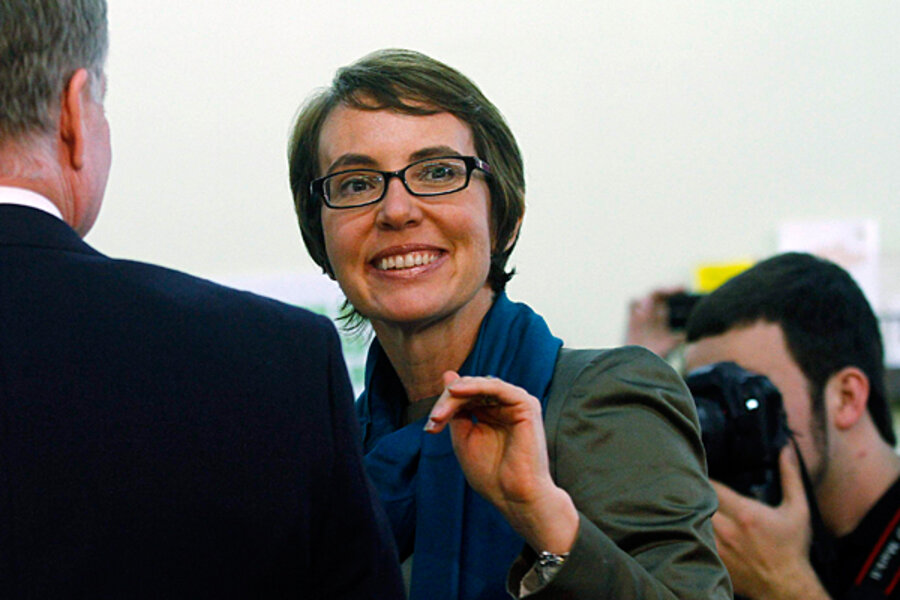Rep. Gabrielle Giffords: what she has stood for in Congress
Loading...
| Phoenix
Although a bullet cut short her tenure in Congress, those who know Rep. Gabrielle Giffords (D) of Arizona say that her innate ability to build bridges will be remembered long after she leaves office.
“She was one of these people, one of the few left in Congress, who could work with people across the aisle and kind of rise above the bitter partisanship that you see in Washington,” says Jeff Rogers, chairman of the Pima County Democratic Party in Tucson, Ariz.
It is only fitting then that Representative Giffords will sit between Arizona Reps. Raúl Grijalva, a Democrat, and Jeff Flake, a Republican, at President Obama’s State of the Union address Tuesday evening. Her appearance comes two weeks after the anniversary of the mass shooting in Tucson that killed six and injured 13, including the congresswoman.
On Sunday, she announced that she would resign from Congress. Once her departure is official, Arizona will hold a special primary and subsequent special election to fill her seat.
“I have more work to do on my recovery, so to do what is best for Arizona, I will step down this week,” she says in a video posted online. Giffords also vows that she will return to politics, and she urges members of Congress to work together across party lines, as she has strived to do.
[ Video is no longer available. ]
On Monday morning, in one of her final acts as a member of Congress, Giffords met privately with survivors of the Jan. 8, 2011, shooting. In the afternoon, she visited a food bank.
Bill Badger, who was shot in the head that Saturday morning and then helped subdue suspect Jared Loughner, says he was grateful to meet Giffords after a year of waiting and wearing a blue silicone bracelet with her name on it. He prayed that one day she would be able to remove it from his wrist.
“It was like a miracle come through, to be able to see her, and how well she’s doing, after such a tragic event,” he says. She kept his bracelet.
The congresswoman’s remarkable progress gives other people with brain injuries hope for recovery, says Mr. Rogers of the Pima County Democratic Party. “People will remember her a lot for the courage she had in coming back from that gunshot wound,” he says.
Giffords narrowly won a third term in November 2010 in a hotly contested election to represent the Eighth Congressional District, which includes a 114-mile stretch of the border with Mexico. She was one of the few Democrats elected to office in the state’s swing districts that year.
“We both had a tough election,” recalls Representative Grijalva, who is serving his fifth term in Congress.
Although the timing of her resignation surprised him, Grijalva says he understands that Giffords needs to concentrate on her health. He has no doubt that if she chooses to resume her political career, the public will stand behind her.
“She has built up so much goodwill and affection from people that she will be in good shape,” Grijalva says.
In Congress, Giffords became a champion of veterans rights and a strong proponent of solar energy. She also was an advocate for increased border security, which earned her support and admiration among Republicans in her district.
“She gained the trust of the ranchers on the border and others who typically are more in the Republican camp,” says Representative Flake, who is running for the seat of retiring Sen. Jon Kyl (R) of Arizona. “She did that because she worked so hard.”
Along with border security, illegal immigration became a hot-button issue during the congresswoman’s 2010 reelection. She opposed Senate Bill 1070, the contested state law that takes a hard stance against illegal immigration. Earlier in 2010, she and Grijalva clashed over his call for an economic boycott to protest the immigration law.
During her last campaign, Giffords expressed support for immigration reform that would prioritize toughened border security but also allow a path to legalization for illegal immigrants. She also pushed for millions of dollars in emergency border-security funding for more Border Patrol agents and surveillance technology.







